China, The Great Depressions 1 & 2, and Gold
Commodities / Great Depression II Oct 13, 2015 - 11:55 AM GMTBy: Darryl_R_Schoon
 When uncontrolled credit growth results in speculative bubbles, capitalism’s cycles of expansion and contraction end in catastrophic deflationary depressions where large collapsing bubbles result in crippling levels of defaulting debt.
When uncontrolled credit growth results in speculative bubbles, capitalism’s cycles of expansion and contraction end in catastrophic deflationary depressions where large collapsing bubbles result in crippling levels of defaulting debt.
In June-July 2015, the Shanghai stock market retraced the beginning of the end of the historic 1920s US stock bubble whose collapse in 1929 ended in the Great Depression of the 1930s; and while it may appear history is repeating itself, it is not. This time, capital markets will not recover.
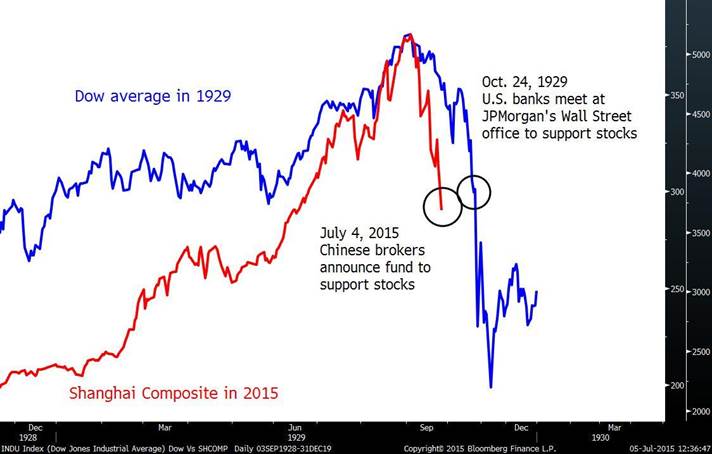
http://www.bloomberg.com/news/articles/2015-07-05/china-brokers-dust-off-wall-street-s-playbook-from-crash-of-1929
While the recent collapse of China’s stock market is similar to the collapse of the US stock market in 1929, China’s economic problems are reminiscent of events far older than the 1920s. One thousand years ago, China began experimenting with paper money, an experiment that set in motion six centuries of economic and political chaos.
Ralph T. Foster’s seminal book, Fiat Paper Money—the History and Evolution of our Currency, describes China’s long experiment with paper money, a tempting but fatal two-edged sword:
Over the course of 600 years five dynasties had implemented paper money and all five made frequent use of the printing press to solve problems. Economic catastrophe and political chaos inevitably followed. Time and again, officials looked to paper money for instant liquidity and the immediate transfer of wealth. But its ostensible virtues could not withstand its tragic legacy; those who held it as a store of value found in time all they had were worthless pieces of paper
p. 29, Fiat Paper Money – The History and Evolution of Our Currency, Ralph T Foster, 2nd ed. 2010
Paper money was banned by China in 1661; but like the proverbial bad penny, it reappeared 33 years later in a far more dangerous guise—as banknotes. In the West, paper money was created not by governments but by money-lenders, i.e. bankers.
In 1694, the Bank of England began printing paper banknotes, a conveyance of debt masquerading as money; the use of which would indebt governments, businesses and society, allowing bankers to parasitically profit from the productivity of others by charging interest on the issuance of money itself.
In keeping with Gresham’s Law where bad money drives out good, paper banknotes eventually supplanted gold, silver and copper coins as the world’s medium of exchange and today, paper banknotes with no intrinsic value are universally accepted as money—and are the primary cause of today’s economic crisis.
Paper banknotes issued as loans tied to central bank interest rates distort the supply and demand dynamics of free markets. Aggregate levels of credit and debt exponentially increase upsetting the requisite balance between supply and demand, causing capital markets to fail.
This is where we are today.
ZERO INTEREST RATES AND GREAT DEPRESSIONS
Zero interest rates appear in capitalist economies when growth can no longer be revived.
Prior to the 1930s Great Depression, zero interested never existed.
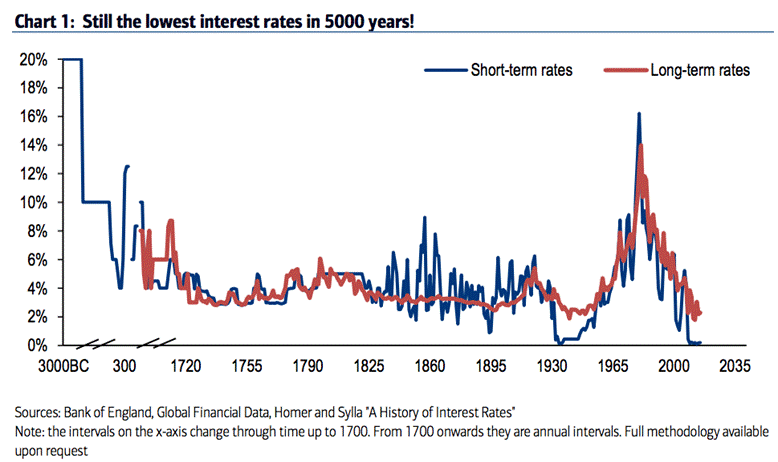
Today, zero interest rates are back.
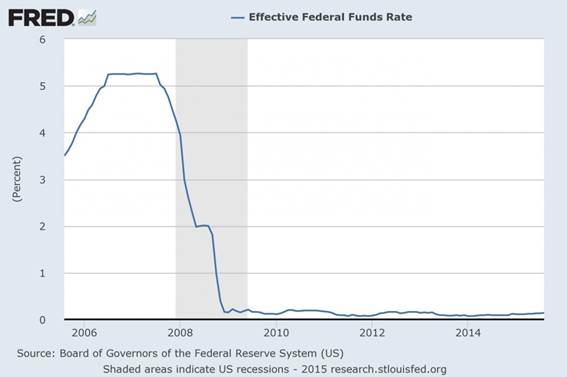
Another Great Depression is coming.
THE GREAT DEPRESSION AND GOLD
Today, the lessons of the Great Depression are almost forgotten (witness the repeal of Glass-Steagall Act of 1933 by Congress in 1999); and those remaining have been ideologically distorted by the supporters of John Maynard Keynes on the left and Milton Friedman on the right.
To truly understand the Great Depression, Buckminster Fuller is without peer. In my youtube video, The History of the US and Buckminster Fuller, see https://youtu.be/Y3ys0DP6ig4 , Bucky’s observations about bankers, financiers and lawyer-capitalism are as relevant today as in the 1930s.
Gold played a secondary but important role during the Great Depression. In a futile attempt to reflate the economy, the US devalued the dollar by raising the price of gold from $20.67 per ounce to $35. Also, by outlawing the private ownership of gold in 1933 bankers forced Americans to stay in paper assets instead of gold, the monetary safe haven of choice throughout history.
Gold also played a role in a short recovery in the Great Depression:
[The] Recovery began in March 1933 with Roosevelt’s banking holiday, ending the fourth banking panic. The nation’s banks were closed for a week during which an army of bank inspectors separated the insolvent banks from the rest. Insolvent banks were closed ending the uncertainty driving the panic. This action was quickly followed by FDR taking the U.S. off the gold standard in April, Treasury gold (and silver) purchases designed to raise gold prices and prices in general, and formal devaluation of the dollar by close to 60% in January 1934. These policies produced a big reflationary impulse from gold inflows which were unsterilized passing directly into the money supply. They also helped convert deflationary expectations into inflationary ones (Eggertsson 2008).
The recovery of 1933 to 1941 was largely driven by gold inflows (initially reflecting Treasury policies and the devaluation, later reflecting capital flight from Europe as war loomed. Expansionary fiscal policy played only a minor role in the recovery of the 1930s.
Michael Bordo, Exits from Recessions: The US Experience 1920-2007
Today, gold will play no such role as America no longer possesses the requisite amount of gold necessary to reflate the economy. America’s once historic hoard of gold—21,775 metric tonnes—was squandered after WWII on maintaining a vast US military presence around the world.
Today, gold is not flowing into the US, it’s flowing out.
CHINA AND THE CRACKUP BOOM
China and the world’s economic powers have now entered capitalism’s crackup boom, the final stage of an unrestrained credit boom:
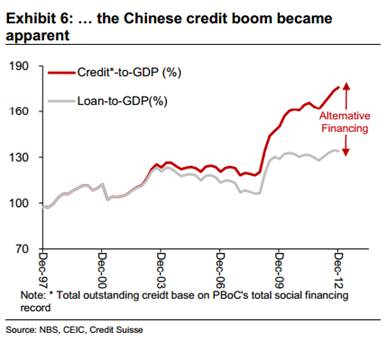
The credit boom is built on the sands of banknotes and deposits. It must collapse… If the credit expansion is not stopped in time, the boom turns into the crack-up boom; the flight into real values [gold and silver] begins, and the whole monetary system founders.
Ludwig von Mises in Human Action, 1949
Capitalism’s crackup boom has now peaked. After the 2008 economic collapse, China along with other emerging markets, e.g. India, Brazil, etc., were recipients of capitalism’s last credit boom; but, today, growth in emerging markets has peaked and their economies are slowing, victims of capitalism’s last credit boom and bust cycle.
The plunge in China’s containerized freight index indicates a global deflationary collapse in demand is underway. The crackup boom is over.
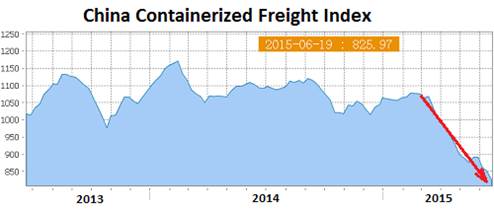
A plunge in China’s rail freight volumes indicates a fall in domestic demand as well.
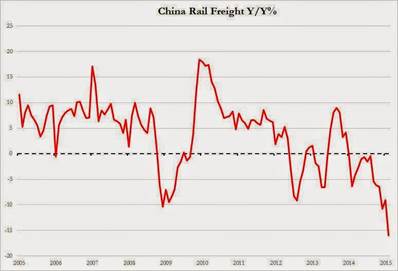
The future is certain. A global Great Depression is imminent.
The World Economic Order is collapsing and this time there seems no way out
Will Hutton, The Guardian, October 12, 2015
WHAT’S NEXT: A DEFLATIONARY COLLAPSE OF MARKETS
There’s a lack of faith in monetary policy -- you’ve thrown the kitchen sink at it, you’ve cut rates to zero, you’re printing money -- and still inflation is [going] lower.
Lee Ferridge, head of macro strategy for North America at State Street Corp., October 4, 2015
http://www.bloomberg.com/news/articles/2015-10-04/world-s-central-banks-lose-bond-market-credibility-as-woes-mount
Today’s levels of NYSE short interest—investors betting stocks will fall on the New York Stock Exchange —is similar to levels just before the catastrophic collapse of markets in 2008.
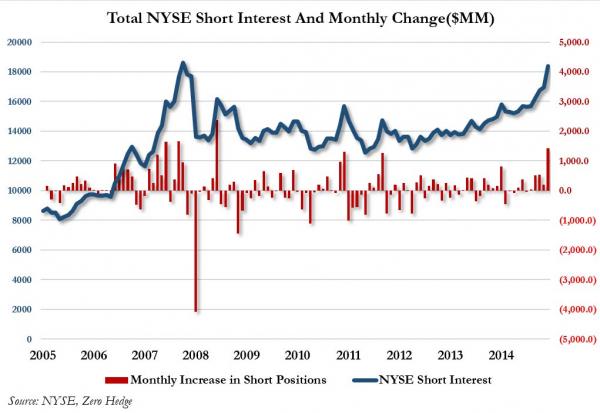
The handwriting’s on the wall and it’s in blood. Stock markets are about to plunge.
The breaking point will be the tipping point
In the second episode, Deconstructing (1) Money and (2) Who We Are, in my new youtube series Moving Through The Maelstrom, I deconstruct “money” and “who we are”, see https://youtu.be/FSTVhue-8i8 . “Money” isn’t what it appears to be and neither are “we”.
These are extraordinary times. It is a period of historic importance. We must do our best. Better times are coming.
Buy gold, buy silver, have faith.
By Darryl Robert Schoon
www.survivethecrisis.com
www.drschoon.com
blog www.posdev.net
About Darryl Robert Schoon
In college, I majored in political science with a focus on East Asia (B.A. University of California at Davis, 1966). My in-depth study of economics did not occur until much later.
In the 1990s, I became curious about the Great Depression and in the course of my study, I realized that most of my preconceptions about money and the economy were just that - preconceptions. I, like most others, did not really understand the nature of money and the economy. Now, I have some insights and answers about these critical matters.
In October 2005, Marshall Thurber, a close friend from law school convened The Positive Deviant Network (the PDN), a group of individuals whom Marshall believed to be "out-of-the-box" thinkers and I was asked to join. The PDN became a major catalyst in my writings on economic issues.
When I discovered others in the PDN shared my concerns about the US economy, I began writing down my thoughts. In March 2007 I presented my findings to the Positive Deviant Network in the form of an in-depth 148- page analysis, " How to Survive the Crisis and Prosper In The Process. "
The reception to my presentation, though controversial, generated a significant amount of interest; and in May 2007, "How To Survive The Crisis And Prosper In The Process" was made available at www.survivethecrisis.com and I began writing articles on economic issues.
The interest in the book and my writings has been gratifying. During its first two months, www.survivethecrisis.com was accessed by over 10,000 viewers from 93 countries. Clearly, we had struck a chord and www.drschoon.com , has been created to address this interest.
Darryl R Schoon Archive |
© 2005-2022 http://www.MarketOracle.co.uk - The Market Oracle is a FREE Daily Financial Markets Analysis & Forecasting online publication.



